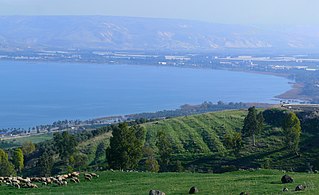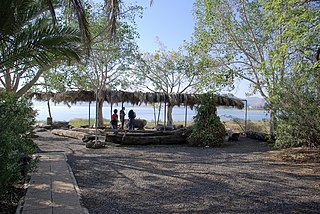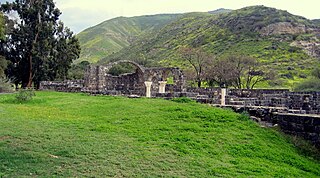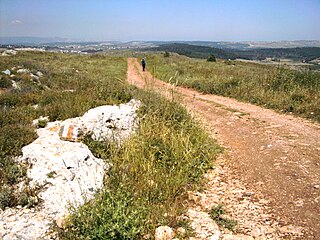
Maritime archaeology is a discipline within archaeology as a whole that specifically studies human interaction with the sea, lakes and rivers through the study of associated physical remains, be they vessels, shore-side facilities, port-related structures, cargoes, human remains and submerged landscapes. A specialty within maritime archaeology is nautical archaeology, which studies ship construction and use.

The Sea of Galilee, also called Lake Tiberias or Kinneret, is a freshwater lake in Israel. It is the lowest freshwater lake on Earth and the second-lowest lake in the world, at levels between 215 and 209 metres below sea level. It is approximately 53 km (33 mi) in circumference, about 21 km (13 mi) long, and 13 km (8.1 mi) wide. Its area is 166.7 km2 (64.4 sq mi) at its fullest, and its maximum depth is approximately 43 metres (141 ft). The lake is fed partly by underground springs, but its main source is the Jordan River, which flows through it from north to south and exits the lake at the Degania Dam.

Capernaum was a fishing village established during the time of the Hasmoneans, located on the northern shore of the Sea of Galilee. It had a population of about 1,500 in the 1st century AD. Archaeological excavations have revealed two ancient synagogues built one over the other. A house turned into a church by the Byzantines is believed to have been the home of Saint Peter.

Magdala was an ancient Jewish city on the shore of the Sea of Galilee, 5 km north of Tiberias. In the Babylonian Talmud it is known as Magdala Nunayya, and which some historical geographers think may refer to Tarichaea, literally: "the place of processing fish." It is believed to be the birthplace of Mary Magdalene. Until the 1948 Arab–Israeli War, a small Arab village, al-Majdal, stood at the site of ancient Magdala. The Israel municipality of Migdal now extends into the area.

Kinneret is the name of an important Bronze and Iron Age city situated on the northwestern shore of the Sea of Galilee, mentioned in the 14th century BC Aqhat Epic of Ugarit, and in the Old Testament and New Testament. Older Bible translations spell the name alternatively Kinnereth or Chinnereth, and sometimes in the plural as Chinneroth. In time the name became Gennesaret and Ginosar. The remains of Kinneret have been excavated at a site called Tell el-'Oreimeh in Arabic and Tel Kinrot in Modern Hebrew.

Bethsaida, also known as Julias or Julia, is a place mentioned in the New Testament. Julias lay in an administrative district known as Gaulonitis. Historians have suggested that the name is also referenced in rabbinic literature under the epithet Ṣaidan.

Tabgha is an area situated on the north-western shore of the Sea of Galilee in Israel and a depopulated Palestinian village. It is traditionally accepted as the place of the miracle of the multiplication of the loaves and fishes and the fourth resurrection appearance of Jesus after his Crucifixion. The village population was expelled in 1948 during Operation Broom.

Dalmanutha or Dalmanoutha is the unknown destination of Jesus on the shores of the Sea of Gallilee after he fed the four thousand, as recorded in Mark's gospel. It is sometimes believed to be in the vicinity of Magdala, the alleged hometown of Mary Magdalene, since the parallel passage in Matthew's gospel, Matthew 15:39, refers instead to "Magadan", which has been taken to be a variant form of "Magdala".

Matthew 4:18 is the eighteenth verse of the fourth chapter of the Gospel of Matthew in the New Testament. Jesus has just begun preaching in Galilee. In this verse he encounters the first of his disciples.

John 6 is the sixth chapter of the Gospel of John in the New Testament of the Christian Bible. It records Jesus' miracles of feeding the five thousand and walking on water, the Bread of Life Discourse, popular rejection of his teaching and Peter's confession of faith. The final verses anticipate Jesus' betrayal by Judas Iscariot.

Kursi is an archaeological site in the Golan Heights containing the ruins of a Byzantine monastery and identified by tradition as the site of Jesus' "Miracle of the Swine". Part of the archaeological site is now an Israeli national park. Kursi takes its name from the Talmudic site. A marble slab with Aramaic text discovered in December 2015 seems to indicate that the settlement had, as of ca. 500 CE, a Jewish or Judeo-Christian population.

Ginosar is a kibbutz in the Plain of Ginosar on the western shore of the Sea of Galilee in Israel. Located north of Tiberias on Highway 90, it falls under the jurisdiction of Emek HaYarden Regional Council. In 2021 it had a population of 597.

The Jesus Trail is a 65 km (40 mi) hiking and pilgrimage route in the Galilee region of Israel that traces the route Jesus may have walked, connecting many sites from his life and ministry. The main part of the trail begins in Nazareth and passes through Sepphoris, Cana, the Horns of Hattin, Mount Arbel Cliffs, the Sea of Galilee, Capernaum, Tabgha, and the Mount of Beatitudes. An alternate return route passes by Tiberias, the Jordan River, Mount Tabor, and Mount Precipice.

Chorazin or Korazim was an ancient village in the Roman and Byzantine periods, best known from the Christian Gospels. It stood on the Korazim Plateau in the Upper Galilee on a hill above the northern shore of the Sea of Galilee, 2.5 mi (4.0 km) from Capernaum in what is now the territory of modern Israel.

Galilee is a fishing village on Point Judith within the town of Narragansett, Rhode Island, USA, and is notable for being home to the largest fishing fleet in Rhode Island and for being the site of the Block Island Ferry. The village is directly across the harbor from Jerusalem, Rhode Island. Galilee, Rhode Island is named after the Biblical Galilee, which was the original home region of Jesus Christ, who grew up in Nazareth, a village in the Galilee region of Israel on the Sea of Galilee. Four of Jesus' disciples, Andrew, Peter, James and John, were fishermen from Galilee.

The calling of the disciples is a key episode in the life of Jesus in the New Testament. It appears in Matthew 4:18–22, Mark 1:16-20 and Luke 5:1–11 on the Sea of Galilee. John 1:35–51 reports the first encounter with two of the disciples a little earlier in the presence of John the Baptist. Particularly in the Gospel of Mark, the beginning of the Ministry of Jesus and the call of the first disciples are inseparable.

The Ma'agan Michael Ship is a well-preserved 5th-century BCE boat discovered off the coast of Kibbutz Ma'agan Michael, Israel, in 1985. The ship was excavated and its timber immersed in preservation tanks at the University of Haifa, undergoing a seven-year process of impregnation by heated polyethylene glycol (PEG). In March 1999, the boat was reassembled and transferred to a dedicated wing built at the Hecht Museum, on the grounds of the university. The boat has provided researchers with insights into ancient methods of shipbuilding and the evolution of anchors.

Fishing in Israel is a branch of the Israeli economy with historical significance. The three main natural fishing zones are the Mediterranean Sea, the Gulf of Aqaba, and the Kinneret. A fourth area that was once historically significant, Lake Hula, no longer exists, as it was drained in the 1950s. In addition, aquaculture the growth of fish in ponds or in cages, is rising in prominence.
Claire Epstein was an Israeli archaeologist. She is noted for her discovery and work on the Chalcolithic Culture in Golan and was a noted member of the Israel Antiquities Authority.

This narrative is told in Luke 5:1-3, Mark 4:1, and Matthew 13:1–3. Owing to the vast crowds that followed him from the surrounding towns and villages to listen to his doctrine, Jesus retired to the sea coast. There he entered a boat, that he used as a pulpit, and addressed the crowd on the shore.
























